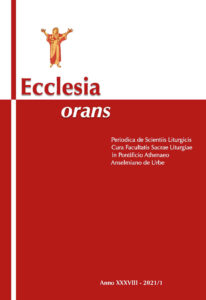Editorial

As the editorial staff is preparing this issue of our journal for printing, we begin Holy Week. This is the second time that we have to celebrate the greatest feast of Christianity with all the restrictions to which the pandemic obliges us. There has been no lack of reflections and studies in liturgical science in recent months attempting to scientifically frame liturgical-celebrative issues in the context of the pandemic. The Pontifical Liturgical Institute had planned the XII International Congress of Liturgy with the theme “Virtual” Liturgy?. It was to take place as every three years in May 2021. Known circumstances have instead suggested postponing the Congress to October 20-22 of this year. In the meantime, many colleague scientists in Liturgy from Italy and abroad have agreed to participate in conferences and communications to contribute to the deepening of the theme from the anthropological-philosophical, historical and liturgical-pastoral points of view.
The present issue of the journal was also designed in view of the topic of the Congress. In the meantime, we had to make some changes in the outline, but the reader will notice that the theme of “Virtual” Liturgy is also present, especially in the contributions of G. Guzmán (Hic et nunc virtuales. Cuestiones de antropología litúrgica), the second part of which will be published in the next issue, and of F. Wernert (La messe télévisée – ce qui fait écran). We also present two studies that deal with the Post-communion prayers: H. Buchinger (Die Postcommunio. Zu Frühgeschichte und Charakter eines eucharistischen Gebetes) and T.A. Krosnicki (Prayers after Communion in the Gothic Missal). The third study focusing on liturgical sources is by F. Bonomo (Un discorso sulle fonti delle esequie nella tradizione liturgica romana).
From the next issue on, the journal will have a new section entitled “Documentation”, which aims to publish papers of different kinds, documenting the life both of the University in general and of our faculty in particular.
We are also pleased to announce the seventh volume in the series of broader studies that accompanies the journal: C.U. Cortoni, Christus Christi est sacramentum. Una storia dei sacramenti nel Medioevo (EOSR 4), Editrice Domenicana Italiana, Napoli 2021, 231 pages, ISBN 978-88-94876-88-8. The author is a professor of the history of theology at our University. We reproduce here the abstract of the volume:
The handbook traces the development of sacramentaria in the Middle Ages in four parts: in the first, the connection between ecclesiology and sacramental life is considered, a relationship strongly marked by the eschatological vision of history; in the second, how the sacraments are treated in manuals, from the early medieval cloistered schools to the advent of Scholasticism in the universities; the third examines the processes that led to a definition of sacrament in general, shared by the majority of the theological schools, and the distinction between sacrament and sacramental, thanks to the fruitful dialogue between theology and law, the fourth is retraced the road that led to define the sacramental septenary, and then treat individually the seven sacraments according to the distinction that was imposed from the twelfth century. between sacraments of necessity (baptism, confirmation, penance, eucharist, anointing of the sick) and sacraments of government (order and marriage).
Expressing sincere thanks to the authors and contributors, and especially to the editorial staff who carried out the work under exceptional conditions imposed by the pandemic, I wish all who pick up the journal and/or the new volume in our series a good read.
MARKUS TYMISTER
Editor in Chief
